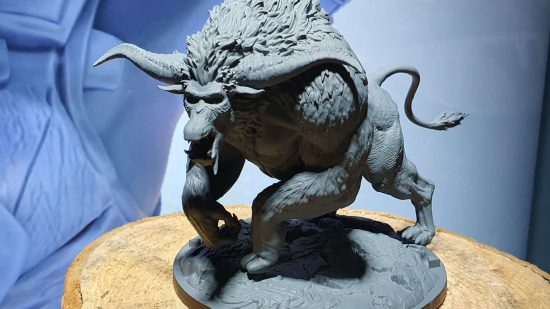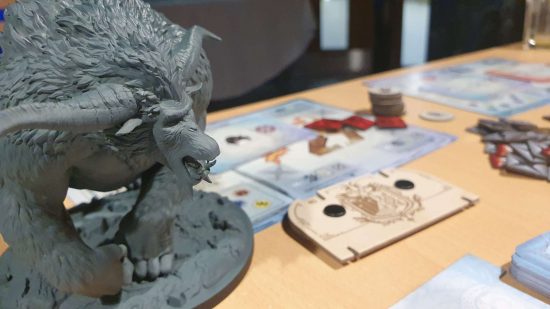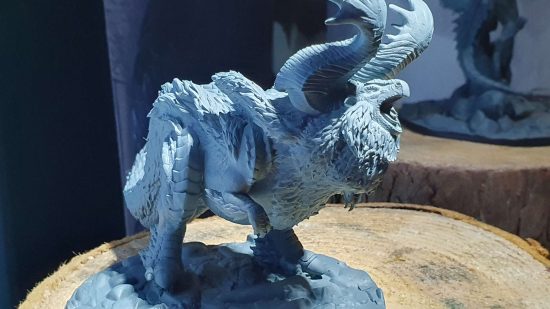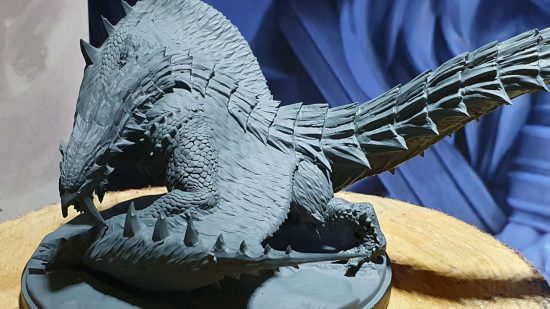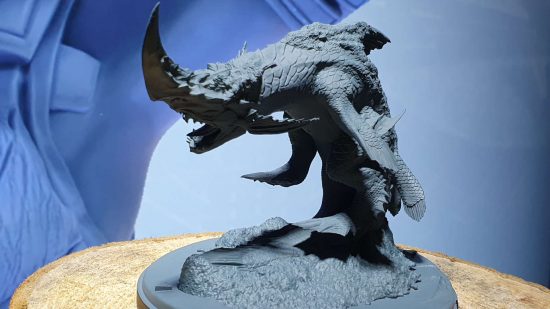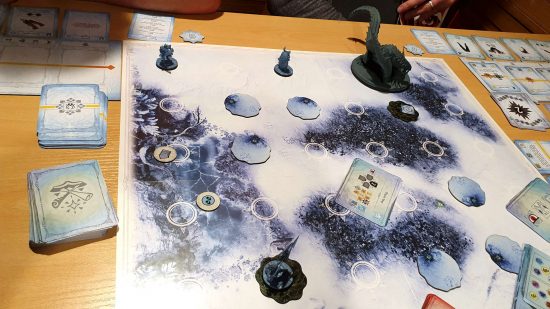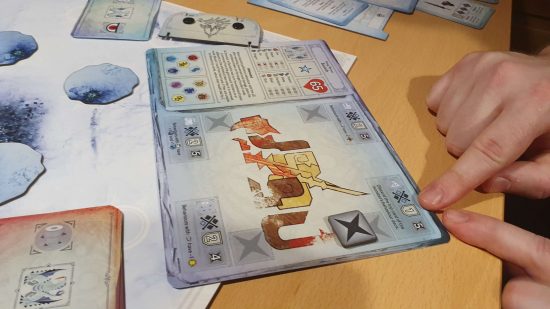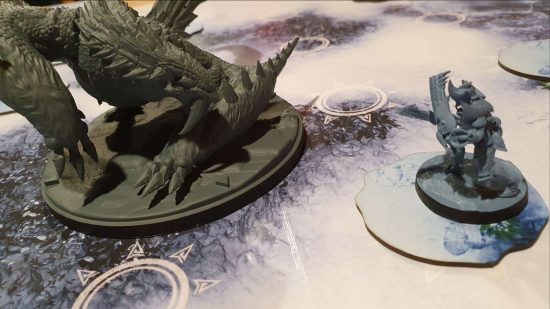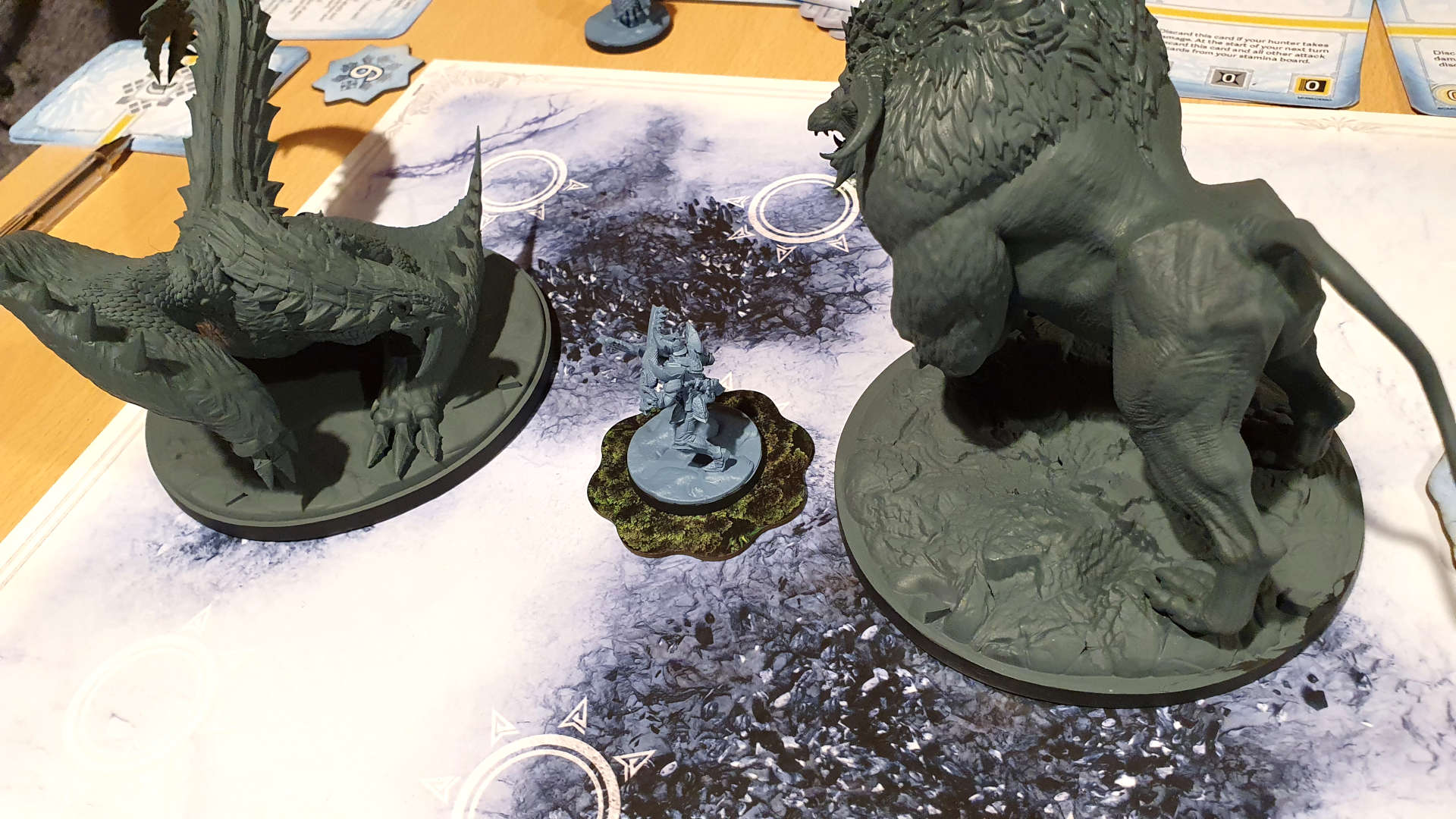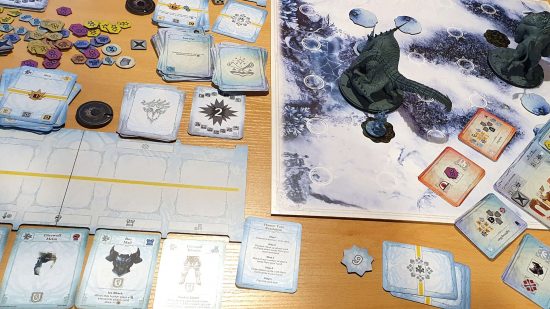On Tuesday, Steamforged Games invited me – and a gaggle of other journos, YouTubers, and assorted nerds – to a demo presentation of its upcoming Monster Hunter World Iceborne: The Board Game. The standalone arena boss-battler board game is coming to Kickstarter on May 18, and Steamforged was keen to show off what potential backers can expect.
Adapted from the Capcom videogame series, Iceborne pits a group of two to four player-controlled monster hunters against a single gargantuan beast. Should you beat this creature in battle – and that’s by no means a sure thing – you’ll turn its scaly hide and frozen fangs into new and better armour and weapons, then do it all over again against something even more dangerous.
Gathering Phase
My demo game saw a party of three hunters stalking a Barioth, a saber-toothed tiger / wyvern hybrid that created deadly whirlwinds all over the battlefield. The starter box also comes with the ice shark Beotodus, the chicken-goat-thing Banbaro, and the electric mega-baboon Rajang, while the core pledge level on Kickstarter adds an expansion with four more – and Steamforged says that plenty more is in store.
Monster-hunting expeditions start with a Gathering phase, representing the time you spend looking for monster tracks and gathering useful resources before starting the fight. This is handled like a choose-your-own-adventure. You’ll have options to follow strange noises, investigate helpful scout flies, or leg-it from enraged snow-apes. Lead designer Jamie Perkins says that he and designer Stephen Margetson are keen to inject more continuity into this part of the game, so that your actions have small but tangible consequences throughout a campaign.
Our choices rewarded our group with a couple of Tracking counters we could use for special effects during the upcoming Hunt phase, and added a couple of special event cards to the Time deck. That deck serves as a clock for the inevitable boss-battle, counting down until the boss gets bored and legs it from the fight, and it’s a chaotic source of benefits and problems during the fight.
The Hunt
The hunters then engage their quarry in the Hunt phase, a battle across a comparatively abstract (though still quite appealing) arena. Here, the monster determines the pace of combat. Rounds start by flipping over the top card of the monster’s behaviour deck, revealing what kind of violence it’s going to unleash on your hunters, and the number of player turns and actions the players will have to do something about it.
Though the behaviour cards initially looked like hieroglyphics to me, they encode some fairly nuanced behaviours. The Barioth retreated from the hunters to blast the party’s backliners with frozen wind, circled our greatsword hunter before sweeping him out of the fight with its tail, went stampeding into melee against another party member hiding in a bush.
An accompanying physiology card lists the beasts special abilities, vulnerabilities, the armour protecting each of the beast’s body-parts – the more of them we could ‘break’, the better rewards we would earn in a campaign game.
Wind-up attacks – the huge, “you’re gonna die” suckerpunches that the Monster Hunter videogames telegraph with lengthy animations – give players an activation or two before the attack unwinds and pastes them. In my demo a hunter with dual blades bore the brunt of all these attacks, frantically dashing beyond the range of a thundering stampede, going on the offensive against a lethal windblast.
The disparity between your hunters and the monster is extreme. Fully armoured, hunters can survive one hit from the monster – if that – while their mightiest attacks merely whittle away at its mountain of hit-points. If you’ve ever been stuck in an RPG where the Dungeon Master throws boring bulletsponge enemies at you no matter what DnD classes are in your party, that description might dispirit you – but I found the combat thrilling.
Combat
On a player’s turn they’ll socket action cards onto their stamina track to move and attack, and they’ll use the same cards and track to dodge away from monster attacks. The stamina track clogs up much faster than you can clear it, particularly if you go all-out on a dodge or a massive combo attack, leaving you vulnerable to sudden pancaking.
It reminds me of the trading card game Flesh and Blood – there’s a similar tension over when to risk a big attack and when to hunker down and muster your resources. There’s an element of Gloomhaven too – the dungeon crawler that many still consider the best board game in the world – as each character’s attack deck and damage deck are unique to their class, and change as they upgrade weapons. Eventually hunters are forced to disengage, as their weapon’s damage deck can only be reshuffled by taking an action to sharpen it.
The Time deck is always running down, spilling out random events as it does. For us that included a sleep toad exploding under the Barioth’s foot and dosing it with sleeping powder that my bow wielder capitalised on with a knock out arrow; and giant frost ape Rajang stampeding onto the hunting ground, dashing around the ongoing melee between our unfortunate Dual Swords hunter and the Barioth, and frazzling them both with lightning.
Turf Wars and more new features
This pitch invasion was called a Turf War, a feature that will be familiar to fans of the monster hunter videogames. Seeing two, frosty kaiju square up against one another was a real “let them fight” moment – though an ape / dragon tag-team would have obliterated our hunters in short order.
Turf Wars isn’t a new feature for Iceborne that didn’t make it into its older sibling, the Monster Hunter World board game, which is just now arriving with Kickstarter backers after funding in April 2021. Though they’re not truly cross-compatible, lead designer Jamie Perkins says there’s enough common DNA that you can take monsters from one game, heroes from the other, and pit them against each other in a one-off fight.
The design off Iceborne isn’t finalised, but there are already some tweaks to systems established in World, Perkins says. A few examples come up while we play: “In World, when you were knocked out you’d lose a couple of Time cards, then return to the battle with all your stamina cleared and all your health – players were using it as a resource. Now you have a limited pool of stamina and health potions for the whole party. It’s a much more difficult choice.” Our greatsword hunter got to experience this system after the Barioth’s tail sweep flattened him into the corner of the arena.
Another new addition is the Clutch Claw. This is a traversal and attack tool that made its videogame debut in Iceborne. In the board game it allowed our poor, beleaguered dual blade hunter to zoom across the battlefield right into the Barioth’s face, and disabled its armour, allowing him to unleash a painful combo of attacks right up its nose.
Our hunt ended in victory. In case you’re suspicious that the decks might have been stacked in our favour by the hosts, other games at the event ended in hunters gored to death.
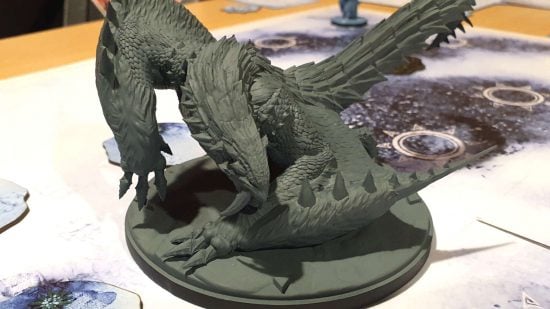
Final thoughts
While I can’t judge the value of a campaign game off a single arena battle, this tickled the tactics-centre of my brain: I’m keen to play more. I’m also a sucker for painting miniatures that are only technically miniature, and if giant monster figures are your thing, this will be a box stuffed with them. I’ve posted an article about the Iceborne board game minis if you’re interested in reading more about them.
The Monster Hunter World: Iceborne Kickstarter will open on May 18. It isn’t the first Steamforged boss battler game: their first massive Kickstarter success was the Dark Souls board game, and their Elden Ring board game adaptation is in production at the moment.
